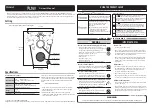
Lake Shore Model 460 Gaussmeter User’s Manual
Operation
3-27
3.17.4 Probe Accuracy Considerations
NOTE:
Probe readings are dependent upon the angle of the sensor in relation to the magnetic
field. The further from 90° the angle between the probe and the field, the greater the
percentage of error. For example, a 5° deviation causes a 0.4% error, a 10° deviation
causes a 1.5% error, etc.
NOTE:
For best results, the instrument and probe should warm up for at least 5 minutes before
zeroing the probe, and at least 30 minutes for rated accuracy. The probe and the zero
gauss chamber should be at the same temperature.
The user must consider all the possible contributors to the accuracy of the reading. Both the probe
and gaussmeter have accuracy specifications that may impact the actual reading. The probe should
be zeroed before making critical measurements. The zero probe function is used to null (cancel) out
the zero offset of the probe or small magnetic fields. It is normally used in conjunction with the zero
gauss chamber, but may also be used with an open probe (registering the local earth magnetic field).
Users wishing to cancel out large magnetic fields should use the Relative function. Refer to
Paragraph 3.9.
Probe temperature can also affect readings. Refer to the two separate temperature coefficients listed
on the specification sheet. The High Stability (HST) probes exhibit a low temperature coefficient of
gain due to the inherent thermal stability of the materials used in its construction.
NOTE:
The following discussion relates to the use of single-axis probes. Three-axis probes are
already set at right angles and therefore do not exhibit these angle induced errors.
When using single-axis probes, readings are dependent on the angle of the sensor (Hall sensor) in
relation to the magnetic field. Maximum output occurs when the flux vector is perpendicular to the
plane of the sensor. This is the condition that exists during factory calibration. The greater the
deviation from orthogonality (from right angles in either of three axes), the larger the error of the
reading. For example, a 5° variance on any one axis causes a 0.4% error, a 10° misalignment
induces a 1.5% error, etc. See Figure 3-7.
Tolerance of instrument, probe, and magnet must be considered for making critical measurements.
The accuracy of the gaussmeter reading is better than ±0.20% of reading and ±0.05% of range.
Absolute accuracy readings for gaussmeters and Hall probes is a difficult specification to give,
because all the variables of the measurement are difficult to reproduce. For example, a 1° error in
alignment to the magnetic field causes a 0.015% reading error. Finally, the best probes have an
accuracy of ±0.15%. This implies that the absolute accuracy measurement of a magnetic field is not
going to reliably be better than ±0.15% under the best of circumstances, and more likely to be 0.20%
to 0.25%.
C-460-3-7.eps
Figure 3-7. Effect Of Angle On Measurements
Summary of Contents for 460
Page 4: ......
Page 7: ...Lake Shore Model 460 Gaussmeter User s Manual ...
Page 8: ......
Page 108: ......
















































